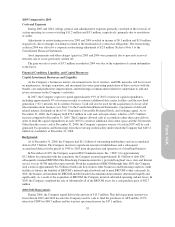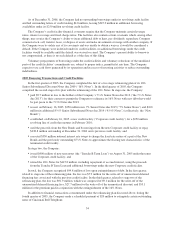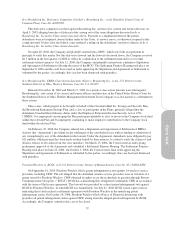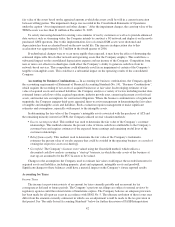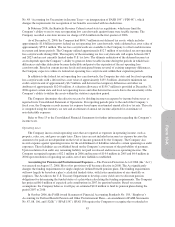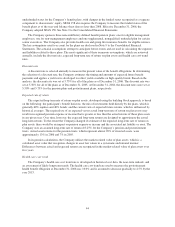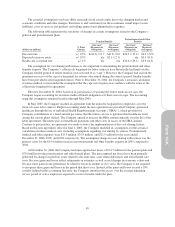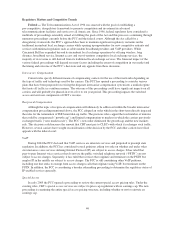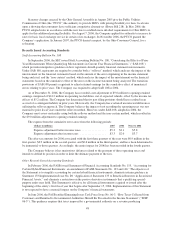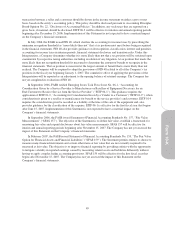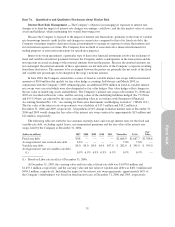Cincinnati Bell 2006 Annual Report Download - page 151
Download and view the complete annual report
Please find page 151 of the 2006 Cincinnati Bell annual report below. You can navigate through the pages in the report by either clicking on the pages listed below, or by using the keyword search tool below to find specific information within the annual report.
Substantially all of the Company’s goodwill relates to its Wireless segment. The Company estimated the fair
value of CBW based on expected future cash flows generated by CBW discounted at 10%. The estimated fair
value of CBW was higher than its carrying value, and, as such, there was no indication of impairment in 2006.
Indefinite-lived intangible assets consist of FCC licenses for spectrum and trademarks for the Wireless
segment. The Company may renew the wireless licenses in a routine manner every ten years for a nominal fee,
provided the Company continues to meet the service and geographic coverage provisions required by the FCC.
The fair value of the licenses was determined by using the “Greenfield” method, an income based approach. The
fair value of the trademarks were determined by using the relief-from-royalty method, which estimates the
present value of royalty expense that could be avoided in the operating business as a result of owning the
respective asset or technology. The fair value of the licenses and trademarks were higher than its carrying value,
and, as such, there was no indication of impairment in 2006.
Reviewing the Carrying Values of Property, Plant and Equipment — The Company’s provision for
depreciation of its telephone plant is determined on a straight-line basis using the group depreciation method.
Provision for depreciation of other property, other than leasehold improvements, is based on the straight-line
method over the estimated economic useful life. Depreciation of leasehold improvements is based on a straight-
line method over the lesser of the economic useful life or term of the lease, including option renewal periods if
renewal of the lease is probable or reasonably assured. Repairs and maintenance expense items are charged to
expense as incurred.
The Company estimates the useful lives of plant and equipment in order to determine the amount of
depreciation expense to be recorded during any reporting period. The majority of the Local segment plant and
equipment is depreciated using the group method, which develops a depreciation rate (annually) based on the
average useful life of a specific group of assets rather than for each individual asset as would be utilized under
the unit method. The estimated life of the group changes as the composition of the group of assets and their
related lives change. Such estimated life of the group is based on historical experience with similar assets, as well
as taking into account anticipated technological or other changes. If technological changes were to occur more
rapidly than anticipated, or in a different form than anticipated, the useful lives assigned to these assets may need
to be shortened, resulting in the recognition of increased depreciation expense in future periods. Likewise, if the
anticipated technological or other changes occur more slowly than expected, the life of the group could be
extended based on the life assigned to new assets added to the group. This could result in a reduction of
depreciation expense in future periods. A one-year decrease or increase in the useful life of these assets would
increase or decrease annual depreciation expense by approximately $10 million.
The Company reviews the carrying value of long-lived assets, other than goodwill and indefinite-lived
intangible assets discussed above, when events or changes in circumstances indicate that the carrying amount of
the assets may not be recoverable. In assessing impairments, the Company follows the provisions of Statement of
Financial Accounting Standards No. 144, “Accounting for the Impairment or Disposal of Long-Lived Assets”.
An impairment loss is recognized when the estimated future undiscounted cash flows expected to result from the
use of an asset (or group of assets) and its eventual disposition are less than its carrying amount. An impairment
loss is measured as the amount by which the asset’s carrying value exceeds its estimated fair value.
During the fourth quarter of 2003, the Company shortened the estimated remaining economic useful life of
its legacy TDMA wireless network to December 31, 2006 due to the expected migration of its TDMA customer
base to its GSM network. The Company made the decision in the first quarter of 2005 to retire certain TDMA
assets in order to optimize its TDMA network performance. As a result of this early retirement of assets, in the
first quarter of 2005 the Company recorded a charge of $23.7 million under the caption “Asset impairments and
other charges.” In the second quarter of 2005, the useful life of certain of the remaining TDMA assets was
shortened from the December 31, 2006 date being used, and depreciation was accelerated. The change in
depreciation expense due to the change in estimate in the second quarter decreased 2005 operating income and
net income by $7.7 million and $4.6 million, respectively; basic and diluted earnings per share were decreased by
$0.02 per share as a result of this change in estimate. In the fourth quarter of 2005, due to the rapid migration of
TDMA customers to the Company’s GSM network and decreased revenue per remaining TDMA subscriber, the
Company determined that the carrying value of the TDMA assets was not recoverable from the estimated future
undiscounted cash flows resulting from the use of the assets. Therefore, an impairment charge of $18.6 million
was recorded in the fourth quarter of 2005 to record the TDMA assets at fair value. The Company calculated the
41




